#north african culture and people are so different
Explore tagged Tumblr posts
Text
going to the middle east for the first time in my life. i still don’t know how i feel about it. the locals are def gonna sniff out the fact that i’m from the west lol (and i’ll be damned if i get a bad bargain on anything when shopping 😤). but i am excited to explore the archaeological sites, history, visit the dead sea, and eat delicious food.
i really hope i can go to my grandparents house in palestine too. and if i do, i hope the IDF doesn’t give us too much trouble on our journey (which is doubtful). either way, im going to make the most out of this trip.
#crazy i never fully experienced my moms culture aside from the bits ive experienced with family here#i know it’s gonna be different than my dads side#north african culture and people are so different#i’m more comfortable with my dads side#they’re more loving and lively#but i’m trying not to judge too harshly#going into this with fresh eyes
11 notes
·
View notes
Text
It's ridiculously and infuriatingly difficult to find some casual history material on the Moors because all anyone cares about is classifying whether or not they were Black... Shut up! I want to know about the arts and the science and the clothing and the crafts and the poetry and the battles and the culture! I don't want to do race science!
#Good Lord.#Oh if I want to learn about any European population's history I'll have no issue.#But fuck me for wanting to know about North Africans. That one's only allowed with generic orientalist music#And the stupid 'but who really were the mysterious Moors and most importantly were they Black or not???'#I for one would like to talk about anything but retroactively applying racial labels that did not exist yet onto historical people.#There is so much more to be learned here but that's all we can ever talk about when it comes to non-white history.#Especially because if you REALLY REALLY REALLY care about trying to classify the Moors...#The fucking answer is some of them in the modern world would be Black and some would not. They weren't a homogenous group.#Can we move on to the vast breadth of culture and influence that is being glossed over constantly now?#I do think it's good to acknowledge many/most Moors would now be considered Black but is that all? Is that all? Really?#It's so diminishing. The obsession in and of itself is antiblack...#The only other groups who anyone cares this much about racially classifying are like. Vikings or whatever and it's always to be racist.#It's always to classify disparate peoples who saw each other as completely different as definitely 100% white. We know why..
3 notes
·
View notes
Text
i find it crazy how whenever there is a persian reference somewhere people will find a way to be racist and invalidate one of the most ancient and noble cultures
#simple exemple: genshin impact incorporated different elements from middle east and north african culture in sumeru including PERSIAN#you will always find people calling an actual PERSIAN reference arabic or indian#like it’s so fucking hard for people to do research or simply listen to actual persian or arabic or indian or whatever ethnicity#when they talk about their culture#getting educated on oriental or north african cultures is so hard right like it’s so demanding to not be racist and ignorant#being respectful of cultures what a crazy concept#i meant people not ethnicity***
0 notes
Text
I don’t like making my own posts, but after waking up to the news that there was a pogrom in the Netherlands, I would just like to say this:
I am a North African Jew. Many would call me an “Arab Jew”, because I look like an Arab and I am treated like an Arab here in North America unless I’m wearing a kippah. My family was terrorized, murdered, and exiled from Libya in the 1960’s and we cannot return because they would kill us
White people may feel uncomfortable saying this, but I do not. Arab society has a problem with antisemitism that must be seen. Middle Eastern Jews have been talking about our experiences with Arab antisemitism for many decades and are constantly silenced. There is an undeniable, vitriolic, hatred of Jews that has been normalized in Arab society, and Arab extremists are now being emboldened to act on that hatred, not just in Arab countries but anywhere in the world
I don’t believe that Arabs are violent or dangerous by nature. They don’t hate Jews by default because they are Arab. This is not about individual Arab people, and individual Arab people should not be punished for problems in Arab countries or the antisemitic actions of other Arabs. This is about the antisemitism that is deeply ingrained in Arab society and culture
Individuals have the opportunity to choose whether or not they want to participate in this hatred. Yes, when you have grown up your whole life being told that Jews are your enemy and that it is good to fight them, it is much harder to make the choice to not act on this because it is all you know, but there are many who still choose peace with Jews. I have many Arab Muslim friends who have no problem being friends with a Jew. My family have many stories about Arab Muslim families trying to save Jews. I have had also many experiences with threats and intimidation and even assault by Arab Muslims because I was wearing a kippah or Magen David
My Arab friends who come to Shabbat dinner at my house and the Arab men who pushed me onto the ground and spat on me and called me a yahood are all equally Arab. The Arabs who call for peace and the Arabs who hunted down Jews in Amsterdam yesterday are all equally Arab. The difference is because my friends and the people calling for peace see Jews as human beings like them, whereas the people committing violence have allowed them to be swayed by Arab nationalist antisemitism
I always hold my tongue when I talk to white people about my experiences with Arab antisemitism or post about them because I know that many people will insist that you can’t criticize Arab extremists without being racist. YOU can’t criticize Arab extremists without being racist because you are a racist white person. I am a North African Jew with firsthand and familial experience with Arab antisemitism both in Libya and in the other places we have lived. I am tired of holding the burden of other people’s racism so I’m posting this without caring if it makes them mad. I’m not going to be responding to hateful responses. I will just block you, so don’t bother
1K notes
·
View notes
Text

How Hadrian’s Wall is Revealing a Hidden Side of Roman History
A party invitation. A broken flipflop. A wig. Letters of complaint about road conditions, and an urgent request for more beer.
It sounds like the aftermath of a successful spring break, but these items are nearly 2,000 years old.
They’re just some of the finds from Hadrian’s Wall – the 73-mile stone wall built as the northwestern boundary of the Roman Empire, sealing off Britannia (modern-day England and Wales) from Caledonia (essentially today’s Scotland).
While most of us think of Pompeii and Herculaneum if we’re thinking of everyday objects preserved from ancient Rome, this outpost in the wild north of the empire is home to some of the most extraordinary finds.
“It’s a very dramatic stamp on the countryside – there’s nothing more redolent of saying you’re entering the Roman empire than seeing that structure,” says Richard Abdy, lead curator of the British Museum’s current exhibition, Legion, which spotlights the everyday life of Roman soldiers, showcasing many finds from Hadrian’s Wall in the process. A tenth of the Roman army was based in Britain, and that makes the wall a great source of military material, he says.
But it’s not all about the soldiers, as excavations are showing.
A multicultural melting pot
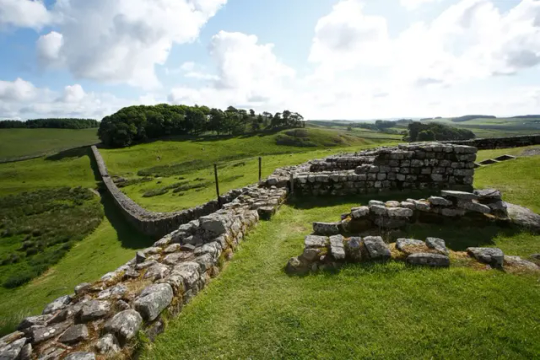
Hadrian, who ordered the wall to be built in 122CE after a visit to Britannia, had a different vision of empire than his predecessors, says Frances McIntosh, curator for English Heritage’s 34 sites along Hadrian’s Wall.
“All the emperors before him were about expanding the empire, but Hadrian was known as the consolidator,” she says. He relinquished some of the territory acquired by his predecessor Trajan, and “decided to set the borders” – literally, in some cases, with wooden poles at sites in Germany, or with stone in Britannia. Where those poles rotted thousands of years ago, the wall is still standing: “A great visual reminder” of the Roman empire, says McIntosh.
It’s not just a wall. There’s a castle every mile along, and turrets at every third-of-a-mile point, with ditches and banks both north and south. “You can imagine the kind of impact that would have had, not just on the landscape but on the people living in the area,” says McIntosh.
And thanks to the finds from the wall, we know a surprising amount about those people.
Although historians have long thought of army outposts as remote, male-dominant places, the excavations along the wall show that’s not the case. Not only were soldiers accompanied by their families, but civilians would settle around the settlements to do business. “ You can almost see Housesteads as a garrison town,” says McIntosh. “There were places you could go for a drink and so on.”
The Roman rule of thumb was not to post soldiers in the place they came from, because of the risk of rebellion. That meant Hadrian’s Wall was a cultural melting point, with cohorts from modern-day Netherlands, Spain, Romania, Algeria, Iraq, Syria – and more. “It was possibly more multicultural because it was a focus point,” says McIntosh, who says that the surrounding community might have included traders from across the empire.
Soldiers were split into two groups. Legionaries were Roman citizens from Italy, who had more rights than other soldiers and imported olive oil, wine and garum (a sauce made from decomposing fish).
They worked alongside auxiliaries – soldiers from conquered provinces, who had fewer rights, but could usually acquire citizenship after 25 years of service.
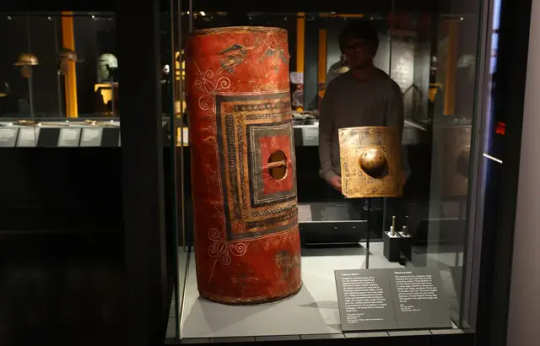
Soldiers carved their names and regiments on stones to show which part of the wall they built – around 50 of them are on display at Chesters fort.
But the wall shows that women and children were equally present.
McIntosh says that pottery brought to the camps – from the Low Countries and North Africa – shows that the soldiers “brought their families, who cooked in traditional style.” Archaeologists have found what seems to be an ancient tagine for North African-style cooking.
A tombstone from Arbeia fort for a woman named Regina shows she was a freed slave from southern Britain who was bought by – and married to – a Syrian soldier.
Another woman buried at Birdoswald fort was laid to rest with chainmail that appears to be from modern-day Poland. “Perhaps she married someone in the army,” says McIntosh, who calls the wall a “melting pot of people from all over the world under the banner of the army.”
“They brought their own religions, as well as worshipping Roman gods and adopting local deities,” she adds. At Carrawburgh, a temple to Mithras – an originally Persian deity – sat near a spring with a shrine to a local water spirit.
‘Wretched little Brits’

Some of the most extraordinary finds from the Roman empire are coming from one site on Hadrian’s Wall: Vindolanda. Here, archaeologists have found a wealth of organic remains because of what curator Barbara Birley calls the “unusual conditions onsite.”
At Vindolanda there are the remains of at least nine forts over 14 levels. “When the Romans would leave, they would knock down timber forts, and cover the area with turf and clay, sealing the layers underneath,” she says.
“Because it happened so many times, the bottom five or six layers are sealed in anaerobic conditions, so things don’t decay. When we get down there, we get wooden objects, textiles, anything organic.”
Vindolanda has the largest collection of Roman textiles from a single site in western Europe, as well as the largest leather collection of any site in the Roman empire – including 5,000 shoes, and even a broken leather flip-flop. “We probably had a population of 3,000 to 6,000 depending on the period, so 5,000 is a lot,” says Birley. For Abdy, the shoes evoke the conditions of the wet borderlands. “Women’s and children’s shoes are hobnailed – you needed it in the mucky frontier dirt tracks. They’re very evocative.”
There’s even a wig made from a local plant, hair moss, which is said to repel midges – the scourge of Scotland during the summer. A centurion’s helmet is also crested with hairmoss – the ancient equivalent of spraying yourself with insect repellent.
The first woman to write in Latin
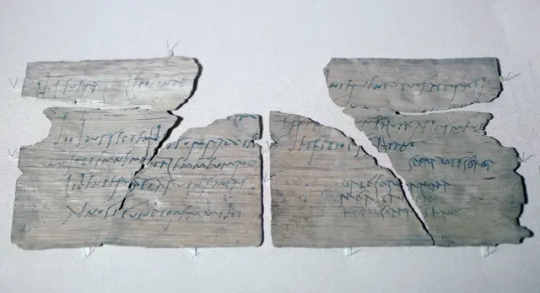
One of the most famous finds is the trove of wooden writing tablets – the largest found anywhere.
“They give a snapshot of what life was actually like,” says Birley. “We understand so much more from written correspondence than from ‘stuff,’ and, archaeologically, it’s the stuff that usually survives – things like metals and ceramics.
“These were written in ink, not on a wax stylus tablet, and we believe they were used for what we’d put in emails: ‘The roads are awful,’ ‘The soldiers need more beer.’ Everyday business.”
The tablets – or “personal letters” as Birley describes them – were found on the site of a bonfire when the ninth cohort of Batavians (in the modern-day Netherlands) were told to move on.
“They had a huge bonfire and lots of letters were chucked in the fire. Some have been singed – we think it may have rained,” she says. One of them calls the locals “Britunculi” – “wretched little Brits.” Another talks about an outbreak of pinkeye. One claims that the roads are too bad to send wagons; another laments that the soldiers have run out of beer.

Among the 1,700 letters are 20 that mention a woman called Sulpicia Lepidina. She was the wife of the commander of the garrison, and seems to have played a crucial role. There’s a letter to her from another woman, Paterna, agreeing to send her two medicines, one a fever cure.
Birley says it’s similar to today. “If you’re a group of moms, still today we say, ‘Do you have the Calpol?’ It’s very human.” For Abdy, it’s a sign that women were traders. “She’s clearly flogging her medicines,” he says. “It’s really great stuff.”
Another tablet is an invite from Claudia Severa, the wife of another commander at a nearby camp. It’s an invitation to a birthday party. Under the formal invitation, presumably written by a scribe, is a scrawl in another hand: “I shall expect you, sister. Farewell, sister, my dearest soul.”
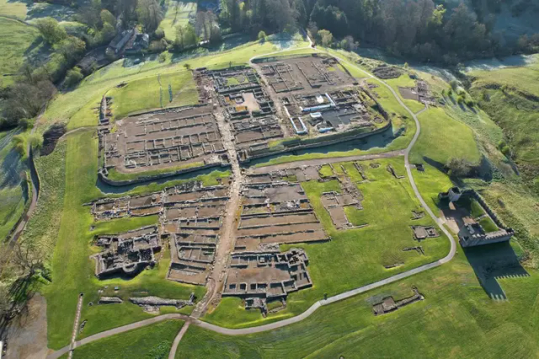
Presumably written by Claudia herself, it is thought to be the earliest example of a woman’s handwriting in Latin.
Without the organic finds – the shoes and the letters that indisputably belonged to women, unlike jewellery or weaving equipment – it’s difficult to prove conclusively that women lived in significant numbers. Vindolanda “illustrate the missing gaps,” says Abdy. For Birley, they prove that women were as crucial a part of army communities as men. “Before the Lepidina tablets were found we didn’t really understand the interactions between the soldiers and their wives,” she says. Another tablet is written by what is thought to be a Spanish standard-bearer’s common-law wife, ordering military equipment for her partner.
“The Vindolanda collection is showing that there weren’t just camp followers and prostitutes; women were part of everyday life, and contributing to the military community in many ways,” says Birley.
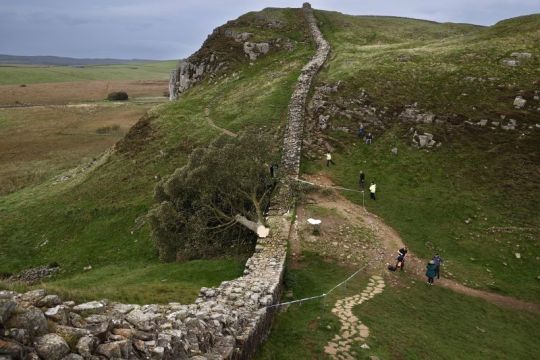

Abdy says that Hadrian’s Wall is interesting because the resident women span “all classes of society,” from Regina – the dead freedwoman, who would have been “bottom of the heap” – to the trader Paterna and the noblewoman Lepidina.
And of course, there’s the wall itself.
“In the Netherlands and Germany the finds are often stunning and better preserved – you go to museums and are bowled over. But in terms of structural remains, Hadrian’s Wall must be among the best,” says McIntosh, modestly, of her site.
Abdy agrees: “I can’t think of many symbols so redolent of imperial will than that wall.”
By Julia Buckley.
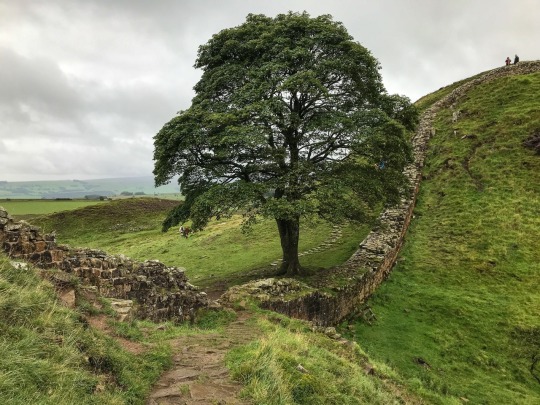
#How Hadrian’s Wall is Revealing a Hidden Side of Roman History#Hadrian’s Wall#emperor hadrian#northwestern boundary of the Roman Empire#Britannia#Caledonia#roman legions#ancient artifacts#archeology#archeolgst#history#history news#ancient history#ancient culture#ancient civilizations#roman history#roman empire#long post#long reads
908 notes
·
View notes
Text
Ok, so there are some people who don't understand why it's insensitive to say that kids learning sign language is great because "they have so much fun having a little secret language", and I take that in good faith and assume that you simply don't know much about history and culture regarding sign languages.
So here's a comparison with oral languages; with minority and endangered languages, to be precise.
I'll start with my own culture, with North Frisian.
North Frisian was prohibited multiple times in history, or at least seen as a "lesser" language, and native speakers were seen as "lesser" as well. There was a lot of discrimination, and as a result my grandma completely forgot her North Frisian variation and her kids didn't learn it. This language is actively revived now, but my grandparents are too old to successfully learn another language, and I have a disability that makes it impossible to learn new grammar. We can't read old letters in that language, a huge chunk of history is permanently lost for us.
If you learn North Frisian while ignoring the culture and discriminatory history of Frisian people, you reinforce the sentiment that it's a "lesser" language; not worth acknowledging that we suffered and sometimes still do. East Frisian is completely extinct, by the way. Most East Frisians speak Low German variations now, but even THAT is a minority language. Even that.
Another example. Australia. Indigenous languages of Australia. You know that native speakers still face discrimination to this day, don't you? You don't? Oh, well they do, they're also seen as "lesser" people and so are their languages. If you learn one of their languages just for fun while ignoring their history and culture, you reinforce the sentiment that these languages are unimportant, not real languages, "lesser" languages.
African languages? You know that these languages aren't dialects but real languages, don't you? You know that you can't ignore culture and history when learning these languages, right? Because, yeah, otherwise you reinforce the sentiment that they're "lesser" languages and that the people who speak it are "lesser".
Alright, most of you people are from the U.S., so... Your indigenous people. Their languages. It's the same here, prohibition, seen as "lesser" people and "lesser" languages. I think you get it by now, right? There was discrimination, there still is discrimination, and the minority language can't be separated from that discrimination because the language itself was discriminated against.
Now... Most sign languages are real languages that developed naturally, did you know that? Most sign languages aren't constructed languages. These languages developed over time just as oral languages did. That's why they're so different from country to county. And most sign languages, just as most oral minority languages, were prohibited at some point because they were, and still are, seen as "lesser". In my country, native sign language speakers were forced to learn to speak with their mouth. There was and is a lot of oralism going on. People speaking sign language were discriminated against and seen as "lesser". Sign language wasn't considered a real language, even though it developed naturally.
And this is still happening, this is still going on today.
Do you see my point? Learning a minority language for fun while ignoring the discrimination native speakers faced and still face, while ignoring the culture that can't be separated from this discrimination, while ignoring the history of that language... reinforces the sentiment that it's a lesser language and that native speakers are lesser.
And this goes for sign languages too. Especially for sign languages, to be honest, because people usually can understand this when it comes to oral languages, but somehow not for sign languages.
That's why it's insensitive to say that learning sign language is fun because it's a "secret language". In doing so, you ignore the culture and history of a minority language.
#people of the cultures I mentioned please feel free to correct me if I made a mistake or used outdated words#long post
278 notes
·
View notes
Text
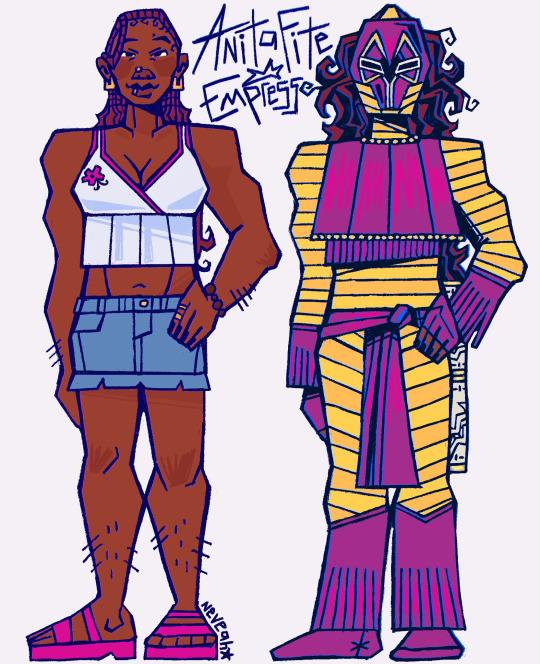
she needs to fight!!! here’s my redesign for anita :)
i felt like something was lacking in her costume and i wanted to take a stab at redesigning her so! here she is!
explanation will be under the cut :]
when i started this redesign, i knew i wanted to incorporate her cultural background a lot more. she is implied (i don’t believe they outright specify it) to practice specifically haitian voodou & both of my parents practice african traditional religions. so, i talked to my dad about different ways to connect that to her costume and he brought up west african masquerades.
i was sent many, many videos (thank u dad 🫡) of masquerades as well as celebrations of junkanoo, which is a festival that started in north america rooted in west african festival traditions & they both have bright colors & masks that i felt really lent itself to the empress costume


i knew i wanted to keep her general silhouette, but i tweaked it to better suit the masquerade & festival costumes e.g. her glove and boot cuffs being flipped.

the stripes were a common aspect, and i based the masks more on junkanoo than masquerades just because of the important meanings behind masquerading that i am not qualified to apply to a dc comics characters ajhdjsja. i also made her under armor a lot more yellow to have less people confuse it as her skin? which i’ve seen a few times.
speaking of, now onto her actual appearance. i think anita has a very cute design, but like many non-white comic characters , it is a bit of a struggle. but! that’s an easy fix.
first, i gave her knotless french curl braids, bc all the black vigilantes i draw have to have protective hairstyles apparently lmao. but also it’s a nice mix of the braids she wears in yj sometimes and her usual hair. yippee



(+ i just made her empress hair a wig, bc it’s very much more convenient & plays into the festival costume aspect)
and, finally, i made her skin tone a lot deeper bc, especially compared to her white teammates, her skin is super gray 😭 which is common for a lot of brown comic characters unfortunately. i could’ve just made her og skintone more saturated but ¯\_(ツ)_/¯ it’s a free country.

and that’s a wrap :^) ty to anyone who actually sat through my rambling! if anything came off unclear i’ve open to questions about it. bring back anita fite 2k24
#anita fite#empress dc#bart (as in bug art)#ANITA I MISS U#i hope my explaination makes sense 😭 me and my dad had like a 2 hour convo about it#i tried to tie the cultural stuff with comic book camp#the skintight like. gold-ish gray was killing meeee#fusha and yellow for the win#young justice#young just us#yj98#dc#dc comics#detective comics
389 notes
·
View notes
Text
While I’m on my ✨Race in Thedas✨ rant let me just explain why the blending of Dalish and City Elves bothers me personally.
As I said previously, I’m mixed. I’m specifically black in the ‘descendants of enslaved people’ way. I grew up in a predominantly white area but finished out highschool in a diverse school with a high number of first gen African immigrants.
(I promise this is pertinent) My relationship with race has always been complex. I benefit from a proximity to whiteness due to being mixed, but I of course still experienced rampant racism and an identity crisis.
In elementary school we had to do a yearly genealogy project. In some ways, mine was easier than the few other black kids in my class. While their families were nearly untraceable past 2-3 generations, I could just focus my effort on my mother’s side. Though, I faced ridicule because OBVIOUSLY I wasn’t white, so obviously I couldn’t be German. While I may have shared DNA, I felt much less experientially connected to the ‘family tree’ I did my reports on because their lives could look nothing like mine. They walked through world without the color of their skin first. So, of course the next year when a culture week came up and we were encouraged to wear clothing representative of our heritage I went the other way—I asked my dad to buy me a dashiki. I still I faced ridicule and still it felt foreign. I had no cultural ties to the patterns, my family never wore them, I’d never heard of the foods we looked up that were mainstays on the Ivory Coast. I may have shared DNA, I may have shared racial trauma, but my culture was different. I was black I wasn’t African.
Playing dragon age origins as a City elf I saw myself for the first time. I saw a woman divorced from her original culture, ripped from her roots by an imperial force but still incredibly steeped in a rich world created by survival and painstaking effort to hold onto oral tradition and what blended history the alienages could. I saw my grandmother singing gospel on the weekends, the church ladies in their outfits, the greens, the pecan pie, the stories of struggle the community shared, the village it took to raise all my cousins and get our older family and friends through chemo and childloss and hard financial times. In hearing about different alienages I saw the distinct cultural differences between Harlem, Oakland, Birmingham, Houston, Atlanta.
Playing as a Dalish elf I saw a facet of the African-Immigrant experience I came to know in high school from my friends who immigrated. I saw the culture more closely connected to the various countries they came from, but still scared by the vestiges of imperialism and colonialism. They were all unique, just as Dalish clans are. My Nigerian friends ate different food, had different rules, wore different clothes, had different cultural practices than my Kenyan or Nigerian friends. I had a couple of North African friends from Morrocco and Egypt that still felt grounded in the history of Africa but were so different. I saw the physical differences in them like I saw them in further DA entires in the Dalish from Antiva or elves from Tevinter.
(And better yet to see this dichotomy in culture I didn’t have to face more trauma porn on black bodies)
As I continued digging into elven cultures in southern Thedas I saw even more complexities of the diaspora that matched my experience. They way both city and Dalish elves looked down upon each other one for ‘assimilation’ and being ‘weak’. The other for holding on to ‘strange’ cultural practices and being ‘primitive’.
Growing up at a crossroads of many racial and cultural experiences I relished in the nuance, the way both cultures were painted as a people just trying to survive and hold onto themselves. A people distinct and resilient, a people not too unlike from each other and while aloof still marginally less wary in solidarity. They were both full of individuals that interacted so vibrantly with the world and life they lived in.
Flattening that in Veilguard initially devastated me, then enraged me. That’s not just poor writing, that’s borderline racist. It indicates that the differences don’t matter, the pain, the struggle, the culture, the history none of it matters because ‘an elf is just an elf’ at the end of the day. And that’s fucking gross.
#dragon age#dragon age origins#dragon age critical#bioware critical#dalish elves#dalish elf#city elf#city elves#fenharel is so swell oooo he makes me wanna yell
63 notes
·
View notes
Note
https://www.tumblr.com/olderthannetfic/768731859531235328/im-a-cis-woman-who-sometimes-likes-to-roleplay-as?source=share
yeah, anon, along with people pointing out that drag is a thing that exists and most drag queens/kings identify as cis outside of that performance (though plenty don't), there's also all kinds of sexual roleplay that doesn't involve wanting to be that thing 24/7. lots of people love to play "doctor" who have no desire to actually go to medical school and become real doctors, because the sexy version is fundamentally different from the non-sexy one. why would playing with gender be any different from that? of course it's true that some people do try those things on as kinks and then it awakens something in them - in the same way that most of us who are into anime knew a "guy" who really liked crossdressing cosplay and would always jump at the chance to do it, and now that person is, well, no longer a guy. sometimes it can be a way to try on an identity that you are considering but not yet sure about. likewise, there are more than a few drag queens who end up realizing that they are trans women down the line. but many more who don't! anyway, my point was that i went through this journey. i used to have a lot of fantasies about having sex as a man specifically, with both men and women - and i played with the idea that i might be trans or genderfluid. but for me, i realized that a lot of the appeal of it was that it was temporary, something i could turn on and off at will (and not just in the sense of gender-expression, but like a complete physical transformation). i wasn't interested in being a man if it meant i stayed a man. i still wanted to be a woman most of the time. (also, i identified as bisexual at the time and these fantasies largely went away around when i realized i was actually a lesbian. i'm not sure what exactly that says, maybe that it was more rooted in anxiety around women's expected "role" in sex than it was about actually wanting to be a man? maybe that the idea of being with a man was more appealing if it was gay, closer to the thing i really wanted? who knows) from when i've talked to trans people about this, a lot of them say it's easy for someone for whom the answer was "i'm trans" to in retrospect see signs everywhere - and therefore assume that the same signs mean the same to other people. and of course, they often feel like they lost years of their lives to an identity that didn't fit them - of course they want to save others from the same fate! but it's just that we all have a bias toward seeing the world through the lenses of our own experiences. that it meant one thing for them doesn't mean it means the same for you, especially in isolation. most cis people aren't totally wedded to everything about our genders, either, and a lot of us play around and experiment with gender in our own ways. (so basically, i see it as similar to those "comphet lesbian checklists" that were floating around tumblr a few years ago - yeah, a lot of those can be signs you might be a budding lesbian, but half the shit on that list is true for women who turn out to be completely heterosexual, too, a lot of it's just about the bullshit of female puberty) again, useful to think of it like anything else. religion is one that comes to mind: oftentimes, a strong hyperfixation on a particular religion or the culture surrounding it can be an early sign that you want to convert to that religion. lots of muslim converts, for instance, talk about being fixated on middle-eastern/north african culture or islamic history for years before they converted. but also, there are just as many if not more people where those hyperfixations turn out to be fleeting ones, or even where it remains a lifelong passion but is purely academic (you meet a lot of them in academia, naturally).
--
54 notes
·
View notes
Text
When I was 16, I attended the Laureate International School in Dar es Salaam, Tanzania, where I followed the British curriculum.
I played sports, and my coach used to organize trips to North Korea.
I was 16 the first time I went in 2015, and 17 the second time I went in 2016.
The camp was very accommodating. All the time, we just felt special.
They were always on our case: "Do you guys need this? Do you guys need that?"
Also, as Africans, we usually tend to have very different traditions and cultural choices.
But out of all the countries that I've been to, North Korea is one of the few that actually has a linkage to our culture.
I remember we spent two days in Pyongyang and went to the war museum and found out that our first president, Julius Nyerere, was actually friends with their first president.[...]
It was interesting to go there and hear about my country from their perspective because our ways of life were so different.
For example, North Korean kids didn't have phones, and even we were not allowed to use phones in the camp.
There was no internet network, but they had service, so we could call through landlines. It was like taking a network break.
When we came out of the camp for visits in Pyongyang, North Korean civilians came and talked to us.
That reminded me of home. If you come to Tanzania, people are going to come and talk to you. They're going to want to get to know you.[...]
My favorite memory was performing in front of a thousand people. Both times I went to the camp, I had to represent my country as a singer.
Tanzanians complained a lot about not having internet on camp.
But that was just perfect for me because sometimes I try to look for the perfect hideout and don't find it.
The scenery was beautiful, lively, and natural.
I also really made long-term friends from the camp, especially with Russian kids.
I'm still in touch with them today. I wouldn't have met them here. Most of them are from Moscow, Nakhodka and Vladivostok.
The only thing close to propaganda that I saw was that when we were at the airport, a friend of mine had some sort of film about the US president and the North Korean president on his laptop.
When we were passing through the last checkup at the airport, authorities somehow saw the clip and had him delete it.
But I didn't feel scared anywhere in the country.
27 Jul 24
102 notes
·
View notes
Note
what are your thoughts on the dune costumes? ive always found them so beautiful and they have left me going down rabbit holes trying to put together my own versions and collections of things i think fitting for the setting. i personally am OBSESSED with the bene gesserit and their look … and naturally lady jessica is an inspiration to us all
I was really impressed by the costuming in the movies, and I adore the attention to detail and storytelling through different clothing. You can clearly see the North African and classical Islamic inspirations
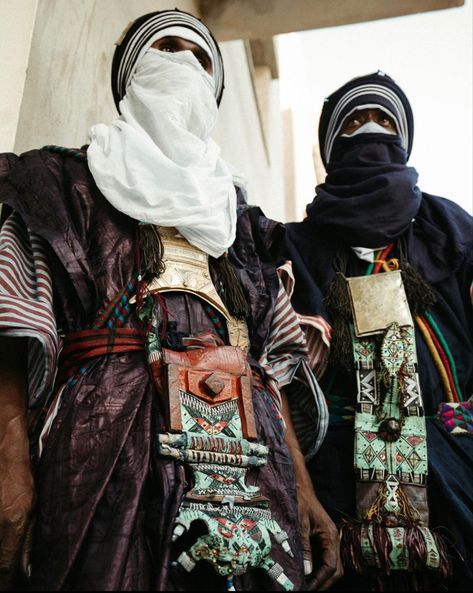
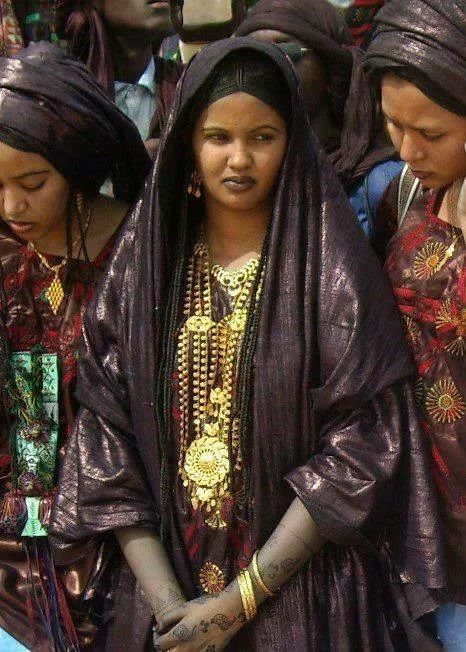

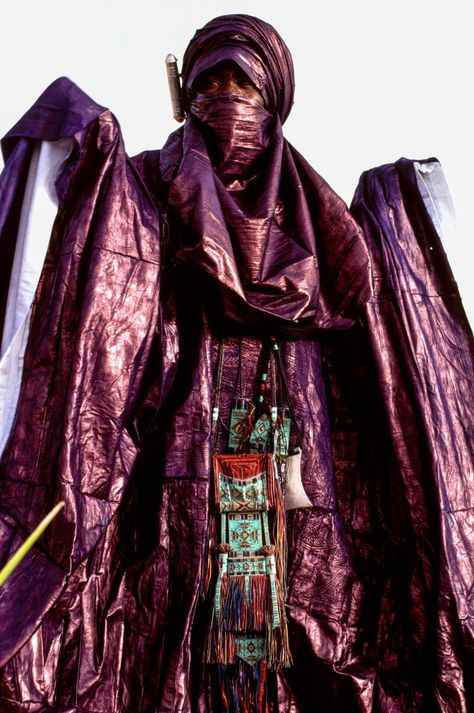
However, the one gripe I have with the Fremen costumes is the lack of color. Like these pics above are clearly the cultures the designers were inspired by, but if you see the newest movie, there is quite a lot of sandy, beige, and brown coloring and little else. Obviously if you live in the desert, you will rely on undyed or neutral colored cloth, but natural dyes are still available in these areas. Even in the book, the sietches are described as having colorful tapestries and color on the walls. The costumes were still beautiful and practical looking, but I do wish there was some individuality. There are a couple scenes near the end where Jessica and her entourage all have on brilliant dyed clothing and headdresses, so it is possible.

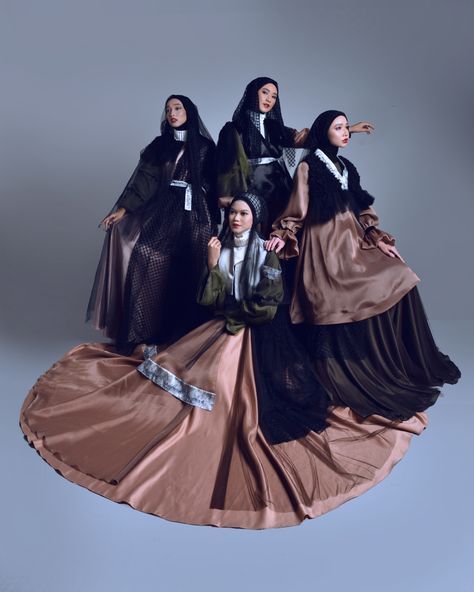
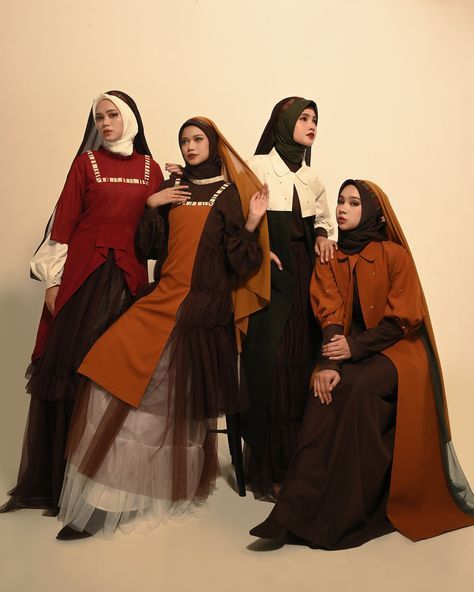
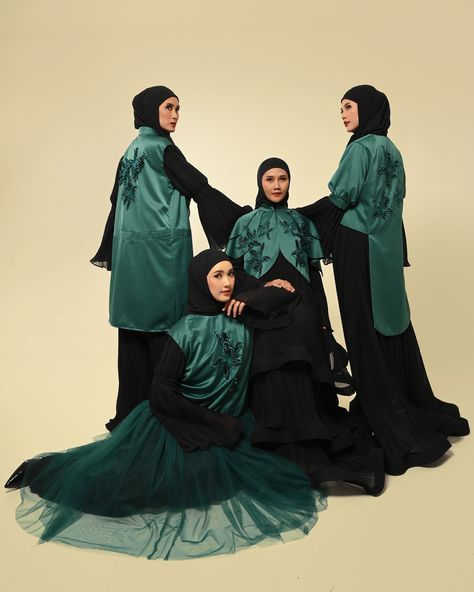

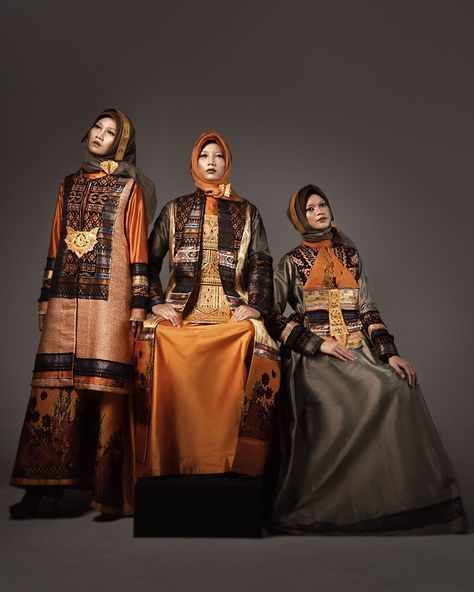
Here's me once again championing for the Islamic Fashion Institute to create all the costumes for future Dune projects, especially the Bene Gesserit show. There's an air of secrecy and mystery to the organization, and I just love the way their costumes shut the sister off from the average person as well as making them stick out as a member of the order. And these pics are giving me very regal secret sisterhood vibes



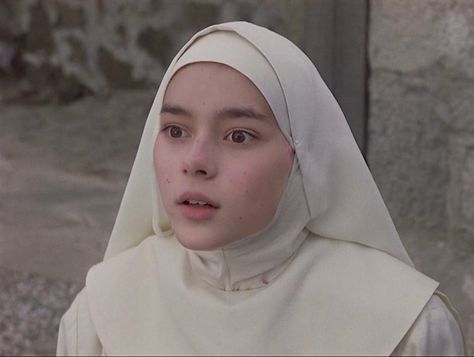
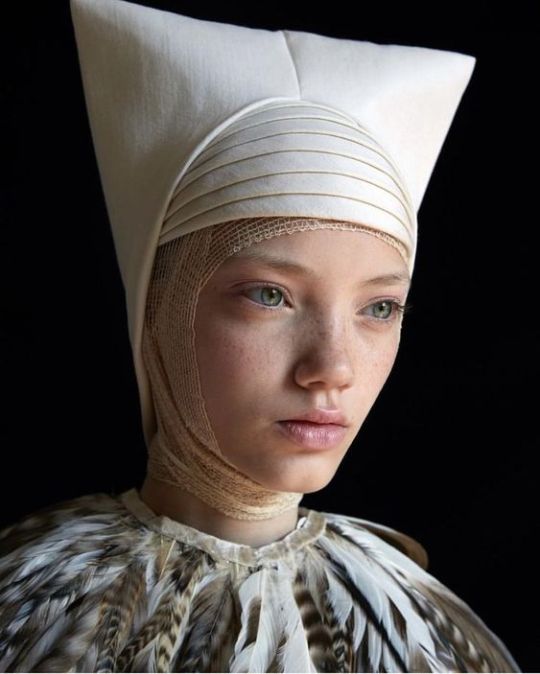

Also the catholic nun inspirations are sooooo palpable I need more people talking about this. All the strange headdresses and veils that put a barrier between the sister and the rest of the world. And not even just the costumes. Pure Catholic arrogance that this coalition of space priests could breed the savior of the world I live for it
178 notes
·
View notes
Text
where is your future spouse from
from left to right; intuitively choose the pile you feel more connected to. To make it easier, you can take a deep breathe, close your eyes and ask for guidance to your deities or guides. These are all general messages, so just take what resonates and leave what doesn't. This reading is timeless. If it resonates, feedback is always appreciated and motivates to keep doing pick a card readings. You can donate here.
dividers: @animatedglittergraphics-n-more


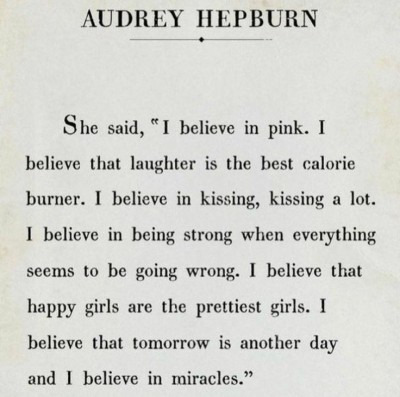
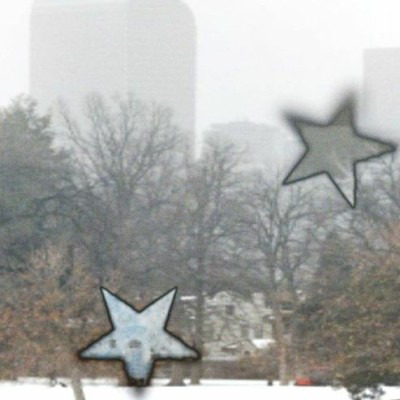

pile 1
I feel like for most of you who picked this pile this person is of Asian descent. Keep in mind that Asia is a big country with many countries and ethnic groups, so I will try to break it down more.
I do feel like for some of you who chose this pile, your future spouse might be of korean origin, but I feel like they will be half white and/or live in the west, like Europe or North America. This message seems to be more true for those of you who have strong scorpio, aquarius and possibly aries influences in your chart. If your name starts with C, E or P or has a more vintage vibe to it, it can still be for you.
For another group who chose this pile, I'm sensing someone of indian origin, I'm getting they could be kashmir and, for some of you, even telugu as well. This feels especially true for those of you that have a strong sagittarius or leo influence in your charts or if your name starts by A, L or U.
I am getting for a minority of people who chose this pile, your fs might be of levantine origin, mainly lebanese and/or palestinian, living most likely in Lebanon, for some of you, or in Southern Europe as of now. I feel like this message is especially true for those of you with strong scorpio, taurus or libra placements. Especially those who get M, S or V as first names.

pile 2
For this pile, I'm specifically getting southeast asian, most likely indonesian and/or malay. I feel like they might be living in Singapore right now. If you are a capricorn, a virgo or a cancer or have strong influences from these signs, this might be the ethnicity of your fs.
I'm getting potentially someone is of sub-saharian african descent mixed with european for some people who picked this pile. I'm getting this person might have ancestors from different parts of Africa and Europe and I'm getting difficulty pinpointing some exact places. I feel like for some of you, they might be west african and partially british. For others, this person could be afrolatino from the caribbean. Signs for this one I'm only getting scorpio and pisces, but I'm also gettingthe initials C, M and D.
There is a smaller group of you that could have a fs from a eastern african country too, potentially Ethiopia or Somalia. I'm getting this is likely true for you especially if you always enjoyed cultures and foods from different african countries, if you like the color red or if your name starts by J, F or E. Potentially if you like orange or are a capricorn rising/sun/moon.

pile 3
I'm getting a strong european influence here. I feel like this person might be italian and, for some of you, of a similar background like iberian, balkan or greek. You will meet them while on a trip to their country or city, if you are from the same country. This might resonate the most with those of you who like the color green, to wear t-shirts or whose name starts with B. If you are a cancer, leo, libra or taurus, this might also be true for you.
For others of you, I'm getting this person might be mexican, likely of a mestizo background. I feel like they might be in the US living right now, although for some it could even be Canada. This might resonate more with you if you like green vegetables like spinach or broccoli, if you like coke, if you like the colors red and pink, if you like mermaids or are of strong aquarius, aries or gemini.
For some of you, although a larger minority, your fs might also be argentinian or brazillian. This can be true especially if you like soccer (I think this one are my guides joking), cinema, romance movies/books, the color white and pink, lana del rey. Alternatively, if your name starts by N, A or Z and your signs are leo, virgo or cancer.

#pac#pick a card#pick a pile#fs pac#fs pac reading#fs pick a card#future spouse readings#future spouse pac#future spouse pick a card#free readings#intuitive readings#tarot readings#love readings#love pac readings#free intuitive readings#free tarot readings
842 notes
·
View notes
Text
(This is about racist TikTok drama, just a heads up if you don’t care about gossip topics lol )
Y’know , I talk a lot about how white-guilt ridden liberals shut down valid criticism of any non white patriarchal society, esp middle eastern, but it’s not just them.
So many people sabotage these conversations, and it’s always racism against Arab people that I find at the root of this problem. It’s esp bad with non middle eastern Muslims that will go to the ends of the world to defend a culture they are not a part of. It’s pure entitlement to speak over members of a race or ethnicity about their own culture. This specific tiktoker is a prime example: layloqasim


There was an Egyptian tiktoker with a small account that spoke about his experience visiting rural Egyptian communities. He didn’t like how these rural folks would refer to women not by their name, but only by their fathers or husbands name (daughter of, wife of). He found it clearly misogynistic, which it was. He was also a tiny account, less than 50k followers.
Here comes Laylo, a Somali woman, not Arab, not Egyptian, not even North African, who attacked him. She got him cancelled and he had to issue out an apology for “Islamophobia” and “racism”. She canceled him for critiquing his own culture.
The entitlement is insane, I can’t stand when people conflate race and religion, esp. because it breeds entitled and ignorant people like her to speak over us. And get this, this was the same time she was getting mad at TikTok for not sending her as much influencer shit as white influencers, saying TikTok was racist and white creators were benefitting from racism. Girl! You’re benefiting from racism too, it’s just people are so ignorant they can’t tell the difference between a Muslim and an Arab so you can treat us however you like 😭
She’s so annoying lol, shes like the poster child of toxic Muslim TikTok
77 notes
·
View notes
Note
AITA for possible cultural appropriation?
I (23NB) have very long hair. I am also autistic and struggle severely with basic self care tasks like brushing my very long hair. I do have people who can help me but I don't like to ask that much of them every day.
To help with this I've been braiding my hair. The problem is that if I just do two braids it all comes out, so I've been doing a kind of cornrows (I think that's the name?) style, to not have to brush it as often and because the braid texture is a good stim.
Some people I know have said that this is racist for me to do. I don't know if this makes any difference but I'm not white, I'm North African.
Before anyone suggests I just cut my hair, that would be extremely emotionally painful for me and I do not want to do that under any circumstances.
AITA?
71 notes
·
View notes
Text
I realized that if I'm disappointed in the transmission of real information about Sudan and the Congo, I can just make the posts myself!
I am not surprised that people haven't been provided a strong understanding of the violence in the global south, but I *am* mad about it.
So let's talk about Sudan and the Congo
Since 2003 or so, an estimated 450,000 Sudanese refugees have fled to Chad, looking for safety from routine waves of ethnic cleansing committed by the Rapid Support Forces and their state/civilian allies.
While the Massalit make up the majority of those attacked, many other ethnicities are included amongst victims. It is NOT a religiously motivated cleansing, as most of those being victimized as well as most of those doing the victimizing are Muslim, and communicate the foundations of the violence as being the result of ethnic-cultural divides in the region current social system. Many of those speaking against the ethnic cleansing occurring agree, and also add that economic interactions appear to be major driving factors in who is targetted and when.
The Congo, meanwhile, has been going through it's own ethnic cleansing. One that has been more or less ongoing since 1996. An approximated 6mil people have been killed since.
Due to this relationship between economic motives and targets, ongoing desertification has been exacerbating violence in the region for years by making resources scarcer, more precious, and less stable to access.
The primary factors being credited with responsibility for this desertification and resultant resource volatility?
Climate change and human impact on the environment (via societal features such as urbanization, agriculture, waste management services, social welfare services, deforestation and bush removal, etc)

From FairPlanet ^
Funny how the global north causes lethal climate change but the global south is forced to die from it.
Funny how the global north forces the environmental recovery conversation to avoid study of environmental imperialism and remain solely focused on "incremental changes that can protect future generations". Whose future generations? What about the people dying NOW because of environmentally toxic industries??
And Nasreldin Atiya Rahamtalla via the International Journal of Social Sciences and Conflict Management says the following:

Hmm, I wonder why local power and social welfare infrastructure in Sudan and especially in Darfur might be diminished from previous governance:
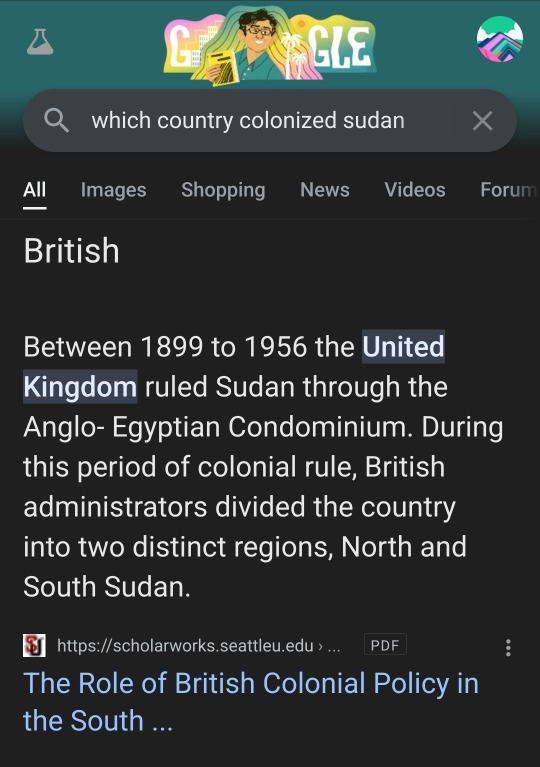

It's almost like the British had a habit of pitting different regional communities against each other along enforced ethnic lines while pillaging some and sparing others, then blowing the whole governance network in a temper tantrum on their way out the door during decolonization, a method of inflicting one last violemt devastation and sabotage peaceful futures most often epitomized by Rwanda and the Belgian Empire:


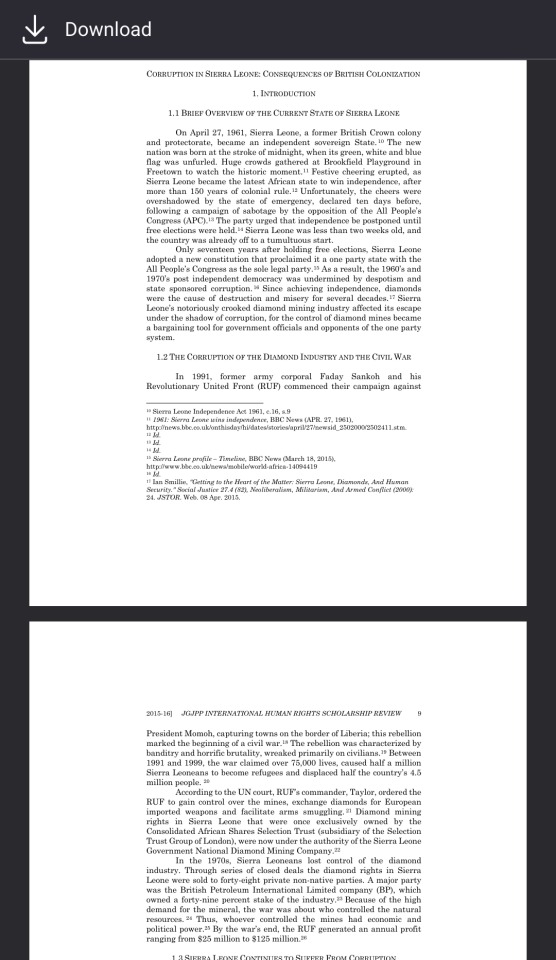
It's almost like the imperialist businesses that feed off African continental resources and were installed during colonization as a form of economic imperialism were often THE ONLY PARTS of the social system left largely functional after withdrawal and "decolonization". It's almost like imperialism and colonization never actually stopped!!! It just??? Changed shape ☆->¤ still a fuckin crime against humanity my guy!!! Especially when child slaves are dying in your mines!!!
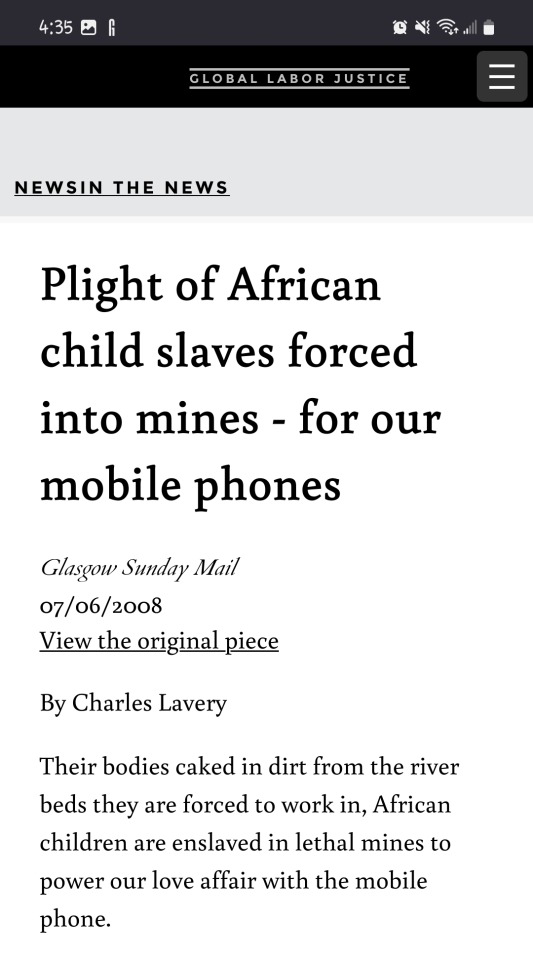
Sudan's economic imperialism comes in the form of Blood Diamonds! You know. The reason that none of us are buying earth mined diamonds anymore when lab made are literally the same goddamn thing RIGHT????????
Oh! They also have oil. The thing we're using to fuel our climate change machine. The climate change machine that's KILLING THEM.
And unfortunately for those of us with Nickel allergies, gold and silver have the same problem. If you haven't already switched to surgical steel, you might wanna. Of course, then we're right back to climate change since steel production allegedly creates a whopping 7% of global emissions due to relying on coke (coal) as a fuel source. So. I dunno really. I like my jewelry as much as anyone. But do I like it enough to know people are dying so I can have it?????
Not really. I'd rather save that risk addition for surgical steel being used in ACTUAL surgeries like the plates, pins, and screws that reattached my foot, or the replacement knee joint that my mom got. At least until we have a body-safe material for these things that ISN'T a source of devastation in the global south.
My point is, basically, that historically militerized conflict almost always stems, at least, in part, from efforts to control resources. It's the most timeless reason to go to war. To make sure you and the people you care about can guarantee themselves access to survival need-meeting. As consumerist and capitalist societies, it is DEEPLY important that we understand the price we ask other people to pay for our luxuries. For our right not to be made uncomfortable by too much radical change too quickly. We need to make that causal link A LOT more visibly explicit and unavoidable, because as it stands, allowing the hierarchy to go unspoken is going to kill billions.
I don't want that on my hands.
I highly recommend learning what civil disobedience and mutual aid infrastructures of care look like. How can we hold corporations (and the individual people who work there) accountable for the countless deaths directly attributable to their profit margins? How can we maximize our local resource distribution to ensure everyone has what they genuinely need to survive, even if that means we take a little less from the community resources for ourselves, or we have to give up things that can't be fully replaced by regionally sustainable alternatives.
I promise that we will adapt.
The dead can't.
77 notes
·
View notes
Note
excellent choice re: will’s new name!
now this is a lore question: was john’s mum from a different tribe than their dad? considering his name is from a different language and tribe than Will’s. we know Will’s mum’s origins, but not a lot on John’s mum. am i veering into lore book spoilers (is there such a thing)
So here's the beginning of the skinny on how Sunjata is organized. Like how my Avalon is loosely inspired by various Medieval-approximate European cultures, Sunjata is loosely inspired by various North-West-Central African cultures. Emphasis on the "loosely inspired" for both nations.
Sunjata is a continent of city-states that has a strong emphasis on technology and trade. It is more technologically advanced than Avalon, with things like aquaduct systems (and more modern-style plumbing!) and dynamite.
The thing that unites Sunjata is a single religion and a single language. Hundreds of years ago, it is said that the god Amun devoured all the other gods, ending their constant battles against one another. With his greatly enhanced divine power, Amun blessed the bloodlines of his most devout worshippers, essentially giving them superpowers. These Blessed Bloodlines went on to conquer the continent and found the great city states that rule over Sunjata today. With the common religion and its conquests came a massive upheaval/movement of people and a common language that swept across the continent (the holdout tribes who continue to worship the old gods are more likely to have held onto their traditional languages as well - these tribes hold the great heresy that Amun did not devour, but instead imprisoned their gods).
Names in Sunjata descend from its variety of pre-Amunite languages and tend to follow certain regional trends, but for Amunites they are no longer connected to specific tribal identities. Sunjati continue to have strong kinship ties, but their cultural identity is generally tied to their city-state and to the Amunite religion in general. Thus you'll have family members with names from different Earth African cultures, similarly to how North American names are a real cultural mishmash (In my own family, my name derives originally from Hebrew and my sister's from Greek, but they're both considered standard American names - Sunjata at this point in history is similar).
That said, John's mother was not from his village. His father travelled often as the village chief, negotiating trade agreements with merchants in the larger settlements and the city-states. He met her on one of those journeys, just as he met Will's mother years after her death.
I haven't yet put together the finer details of Sunjati culture as I plan to do a lot more reading, research, and consultation before writing my second game (set in Sunjata with a Sunjati MC).
23 notes
·
View notes